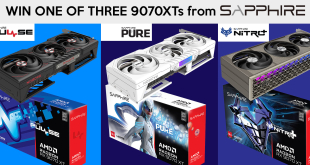For a mid-tower case, the Obsidian 650D is quite large. Some manufacturers would try and disguise this be incorporating a series of curved plastic panels but Corsair has opted for a much more simple square design for the case. This is no bad thing, though, as the 650D is actually quite attractive to look at.
Corsair have chosen to finish the front of the 650D in black brushed aluminum which looks and feels much more exclusive than steel or plastic. Even though the rest of the case is constructed from steel, this seems to be good quality and gives it a reassuring weight.
The front panel connections are disguised behind a flap which opens to reveal pretty much everything we could ask for. From left to right there are two USB3.0 ports, headphone and microphone jacks, two USB2.0 ports and a firewire port. The power button is illuminated white when the system is on and is located on the left side of the front panel flap next to the HDD access LED.
The reset button is hidden beneath the flap, though, to the right of all the connections. On the top of the case at the front there is a small flap which slides back to reveal a hard drive docking station. There is also a fan speed control located under this flap which lets you tweak the noise level of the case.
In the roof of the case there is a sizable fan grille which has mounting points for pretty much every fan configuration you could want. The case is supplied with a 200mm exhaust fan installed but this can be replaced by two 140mm fans or two 120mm fans. There is an additional 200mm fan in the front of the case which acts as an intake. This is covered by a removable mesh panel which has an integrated dust filter.
Moving round to the rear of the case we find the usual 120mm exhaust vent populated with a Corsair branded fan. The case features eight vented expansion slots and two external watercooling holes which contain rubber grommets to stop dust from getting in.
The PSU mountings are located at the bottom of the case with a vent on the underside to feed the fan with cool air. This vent features a dust filter which can be easily removed from the rear of the case.
 KitGuru KitGuru.net – Tech News | Hardware News | Hardware Reviews | IOS | Mobile | Gaming | Graphics Cards
KitGuru KitGuru.net – Tech News | Hardware News | Hardware Reviews | IOS | Mobile | Gaming | Graphics Cards









awesome, stunning engineering. Who make their cases incidentally? I know they dont make anything really themselves, but use ‘sources’? would it be silverstone or lian li?
Awesome ! very nice design. corsair rock
Lian li wont make for anyone else. but I am sure they have the assistance of a factory group in the far east. One thing ive noticed about corsair lately is they are actually more of a ‘marketing’ brand now. sourcing components from other groups and rebadging them with their name etc. they do it very well.
The internal design sets these apart. many manufacturers like bitfenix focus on the outward appearance and clutter them up, but the real basis of a great case is airflow and structuring, internally.
love their cases, they spend a lot of time working on the internal side of them.
Yeah I like their cases too. they aren’t lian li expensive either. some of the lian li stuff costs as much as my computer ! just for the case
THey are good, but our local computer store has one and I can hear a very slight rattling from the fan. It might just be a bad fan, but it can be heard, I have sensitive ears.
I tried putting pressure on the panel but it didnt cure it, so I assume its a bad fan, rather than a seating problem.
I’m pretty sure Thermaltake use the same motherboard tray in their Chaser MK-1 case, I don’t know if Thermaltake have their own manufacturing facilities or not, consequently I don’t know if Corsair use Thermaltake, or if they both use the same manufacturer for those cases.
@Ned
As for Lian Li not making cases for anyone else, don’t Lian Li make Cubitek’s XL Tank and HTPX Tank cases? I can’t remember where I read that, but my guess would be in TPU’s review of the XL Tank.
Also, haven’t Corsair always just sold what other people/companies make?
thermaltake? really. Shame they didnt make their own cases more like this if thats the case..